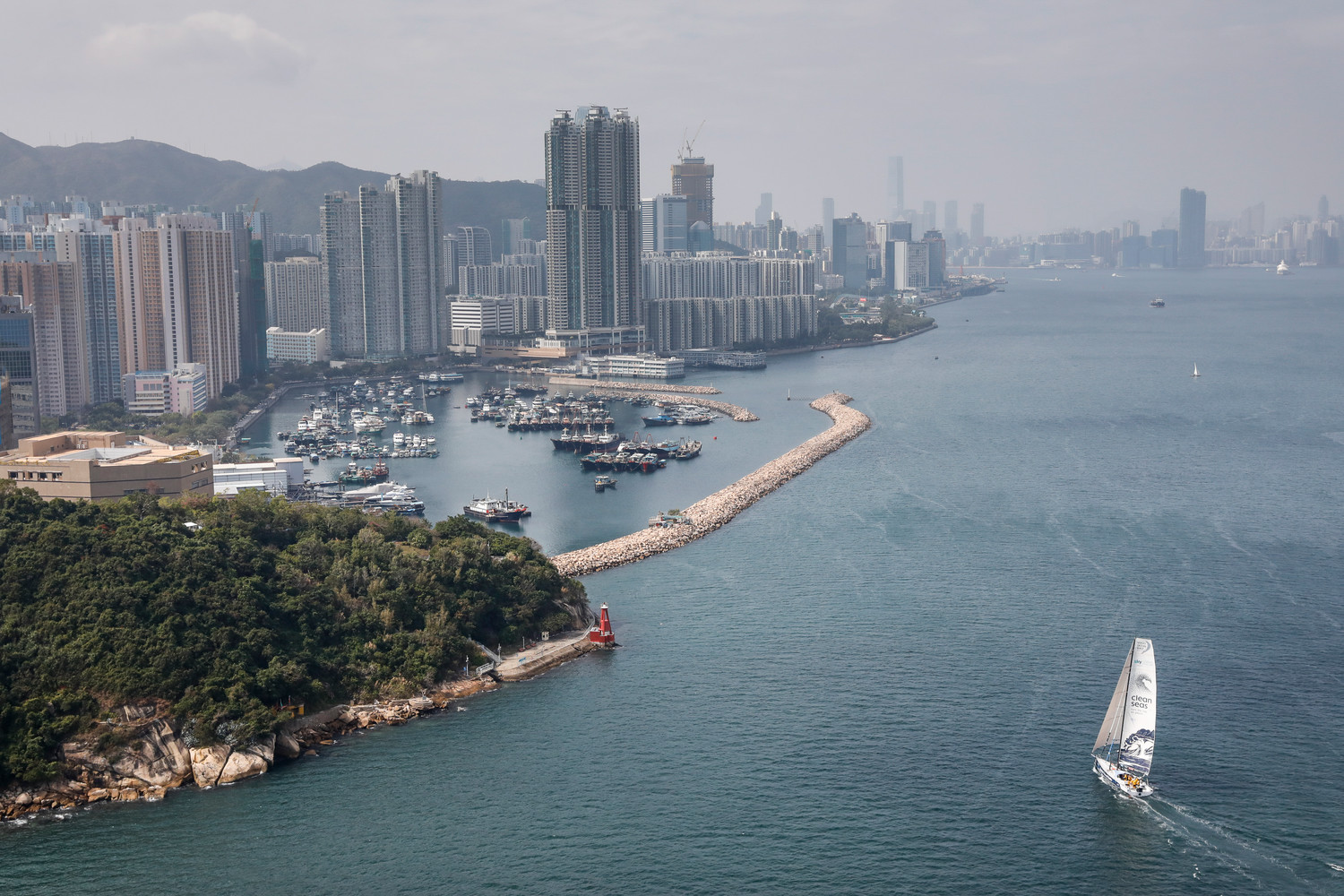
Sir Ben Ainslie was quoted as saying, ‘it is better to be lucky than good’. On this leg we were good but sadly not lucky and the others, well, they were both good and lucky.
We had just one week of rest after Leg 3, which was a wet, cold and tiring leg. We were able to enjoy New Year, but had a great deal of boat preparation to ensure we were ready for the next 5500 miles of sailing. As a result, we were already fatigued at the start of Leg 4 and this started to show when we were a few days into the leg. However, we were hungry to keep on the pace with the fleet, had great sailing conditions and the adrenaline was flowing.
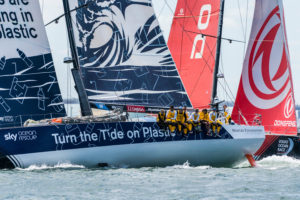
It was a windy start to the leg with wind against tide conditions at the end of the bay and we powered through standing waves to get into the Bass Straits. We were now sailing away from Melbourne fast. At the bottom corner of Australia, we were sailing in 25 knots and had reached our first exclusion zone. We were able to bear away and sail downwind with a sail change to the MH0. All the fleet were in sight and we carried out the same action together. It was then a case of gybing through the islands in strong winds. One Island, called Big Rock, was on our bow and we timed our gybe appropriately. However, by the time we were ready to gybe, Scallywag were on our inside and we were forced to wait. It was way too close for comfort as illustrated by the breaking waves in front of us. We shouted across to Scallywag and as soon as we saw them start to turn we gybed simultaneously.
The breeze then decreased as we sailed along the coast of Australia, gybing into the coastline to stay inside of the shift. Just after a bay ominously called ‘Disaster Bay’ we started our long gybe offshore on starboard. It was time to sail in a straight line for once and the team benefitted from having some much needed off watches. We did a few gybes on some wind shifts but strangely this set up on starboard was us pretty much all the way to Hong Kong – very unusual on a 5000 mile leg!
We were sailing towards the first mark of the course, Santa Ana Island at the end of the Solomon Islands. The aim was to sail as fast as possible in a northerly direction and we arrived at this mark alongside Vestas and just behind AkzoNobel, Dongfeng and Mapfre.
We started heading just west of north making ground in light forecast winds along the north of the island chain and managed to close the gap to 3.8 miles. It was so exciting that at day 7 we could still see five boats with the naked eye and could easily see right to the front of the fleet.
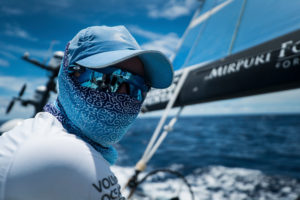
We battled light winds for five days, moved into the lead and stayed there. Life was taking a turn for the better for Turn the Tide on Plastic racing. As the position reports came in, the pecking order was constantly changing as we negotiated the cloud activity in the area. Wind pressure ranged from 1.8 knots to 4 knots and any time we spent with real wind was short lived. It was tough. Air temperatures reached 40 degrees and the sea temperature peaked at 30 degrees. There was nowhere to hide from the intense heat and fuses were short as people became frustrated and tired from lack of wind and high temperatures. It was also from the self-imposed stress of success, fickle winds and frustrating cloud activity. Morale was high as we held with the front of the fleet, sailing well and convincingly. We began to believe that we should be there and this was a huge step in self-confidence and competence.
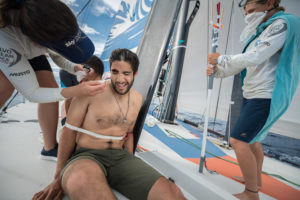
The equator crossing was a milestone for Bleddyn and Bernardo. This was celebrated by a visit from Neptune and some very random haircuts for both the boys. Sadly, the sacrifice didn’t seem to be enough to appease the wind gods as, shortly after the crossing, it was evident that we had fallen out of favour.
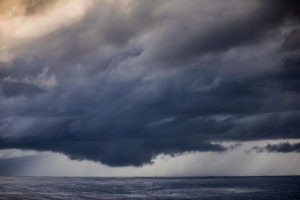
It was the cloud activity on just one night that changed everything for us. We were sailing alongside Brunel and Mapfre, in the middle of the fleet but were unable to head north to get to the new wind. We decided to compromise with a north west heading to make some better VMC to the finish while we negotiated light winds and clouds. The big clouds left, and some new wind filled in. To take the heading we wanted would have sent us into the clouds that were trying to suck us back into the turmoil that we desperately wanted to leave.
Mapfre were the first to the new breeze beyond the cloud line and sailed high to clear the grip of the clouds as they disappeared over the horizon. It took us longer to reach the wind and by that time Brunel had come with us. Now the reality of our situation was delivered as a harsh blow in the position report. Not only had the eastern group picked up the wind, they were 70 miles clear and sailing away at a good pace. Mapfre had separated from us by 14 miles and Scallywag to leeward had also broken clear ahead and were sailing forwards of us by 60 miles. This was grim news to minds that were already tired and fragile.
The middle of the fleet had been left floundering and it stung us hard to have worked so hard only to have it all taken away from us. We had been playing at the front of the fleet and one night of clouds had totally reversed our fortunes. We were all gutted and it would have been easy to let our heads drop and give up but that wasn’t going to help make us go faster or get us back in the game. There were still many more miles to sail and a long way to go and, as we had just found out to our cost, anything can happen.
Doldrums squalls all cleared and now it was about sailing as fast as possible in a drag race to the finish. There were now islands, atolls and reefs to negotiate that all seemed to fall on our path and draw us in like magnets.
We split from Brunel at the first island with them coming up to the north and us doing short gybes to go south of the land. It felt like groundhog day with the watch brief being delivered with the same message. The weather was not really changing just a variance in the pressure. There were some lifts and headers but the goal always to sail towards 290 – 300 course as fast as possible. We made small gains into Mapfre and maintained with Brunel and we knew the finish was going to be close. Scallywag were clear ahead and secured a home port win – nice work by them.
The final 1000 miles was stressful and our aim was to try and finish ahead of Brunel. We played the shifts trying to ensure we had the fastest boat speed. We gybed, they didn’t, we were faster, they were faster. It was a long three days to the finish and it was the final islands in the Luzon Straits that made the difference. Brunel gybed south and kept the advantage.
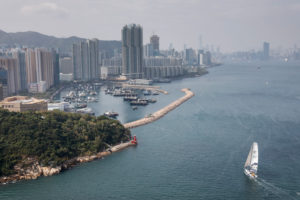
Yet again we were to finish last and it was not the result I feel that we deserved. Overall it was a great leg sailed well and I am proud of the tenacity and resilience of my team, they really are an inspiration.
The crew were deeply saddened by the news that a collision between Vestas 11th Hour Racing and a fishing vessel on Friday resulted in a man tragically losing his life. Our deepest condolences go out to his loved ones and family.